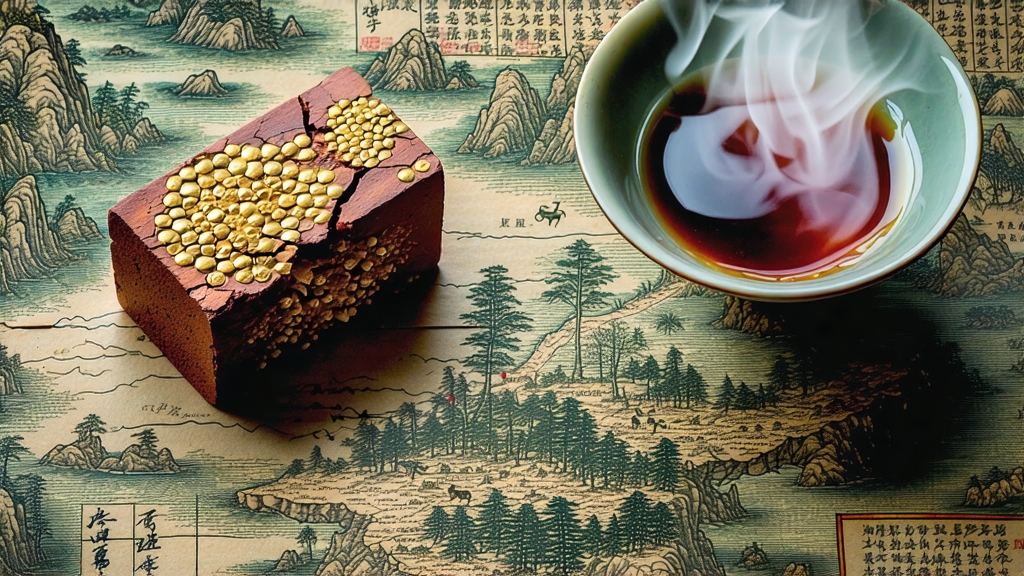
When most tea lovers outside China hear “dark tea,” they picture the mellow, earthy disks of Yunnan Pu-erh. Yet four provinces to the north-east, in the humid mountains of Hunan, another brick has been quietly fermenting for more than six centuries. Fu Zhuan—literally “Fu brick”—is the only tea whose finished form is judged not merely by leaf grade or vintage, but by the density of a living microorganism blooming inside it. These tiny golden spores, Eurotium cristatum, nicknamed “golden flowers,” look like powdered starlight scattered across the dark matrix of pressed tea. Their presence is so prized that the National Standard of China (GB/T 9833.3) sets a minimum threshold: 50,000 colonies per gram of authentic Fu Zhuan. To understand this tea is to follow a caravan route, a microbiology lab, and a tea master’s wrist in one story.
Historical caravan
Fu Zhuan’s origin is inseparable from the Ming-era Tea-Horse Road, a 3,000-kilometre braid of mountain paths that exchanged Central China tea for Tibetan warhorses. In 1368 the imperial court designated Anhua county, Hunan, as one of four official “Tea Offices.” Compressed bricks were easier to strap onto mules than loose leaves, and the 32-stop journey to Lhasa took up to six months. During that time tea absorbed moisture from subtropical jungles, then alpine frost, then desert dryness. The fluctuating humidity seeded wild fungi, darkening the leaf and smoothing its smoke. Tibetans soon preferred the taste, claiming it cut yak-butter richness and aided digestion of high-protein diets. By the Qing dynasty the court codified the brick’s weight (exactly 2 kg), size (35 × 18 × 3.5 cm), and even the position of a central groove so that traders could thread ropes without a scale. Thus Fu Zhuan became one of the world’s earliest standardized commodities, centuries before the London Tea Exchange.
From leaf to brick: the craft today
Modern production still clusters around Anhua’s Meishan mountains, where 80 % relative humidity and mean temperatures of 26 °C provide an open-air incubator. The season begins after Grain Rain when tea bushes flush with one bud and three leaves. Pickers pluck before ten a.m., sending leaf to the factory by lunch. The first step, “kill-green,” fires leaves in a rotating drum at 280 °C for ninety seconds—just long enough to halt oxidation enzymes while preserving surface microbes. Next comes the unique “song” rolling: leaves are tumbled inside a bamboo cage lined with horse-tail grass, bruising cells without breaking them. Rolling lasts 45 minutes, after which the leaf smells of green walnuts and wet slate.
The pivotal phase is wet-pile fermentation, a controlled composting borrowed from Pu-erh yet distinct in scale and flora. Leaves are piled 70 cm high, misted to 28 % moisture, and covered with hemp cloth. Every twelve hours a worker called the “turner” climbs atop the pile, barefoot, to insert a long bamboo thermometer. When the core hits 62 °C he forks the heap inside-out, aerating and cooling. After seven days the leaf has turned chestnut-brown and exudes a faint dried-jujube sweetness. Now comes the step that separates Fu Zhuan from all other dark teas: inoculation. A spore-rich powder cultivated on steamed rice is sifted over the pile. Within 48 hours the first yellow dots appear; within a week the surface looks dusted with pollen.
Pressing follows while the leaf is still warm. A wooden mold lined with cotton cloth receives exactly 1.98 kg of tea—allowing for 0.02 kg moisture loss. Two stone blocks are lowered hydraulically, but the final torque is applied by a craftsman who stands on the upper block, arms outstretched like a tight-rope walker, shifting his weight until the brick clicks into its steel frame. Bricks are then wheeled into the “flower room,” a humidor kept at 28 °C and 85 % RH. Here the golden flowers bloom for 15–20 days, consuming residual starch and releasing enzymes that convert flavonoids into soluble antioxidants. A finished brick leaves the room weighing 2 kg on the dot, its surface mottled like a meteorite flecked with stardust.
Tasting the quiet storm
To brew Fu Zhuan is to